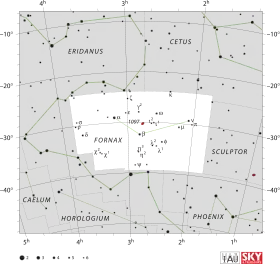Beta Fornacis
Beta Fornacis (β Fornacis / β For) est une étoile solitaire[7] de la constellation australe du Fourneau. Elle est visible à l'œil nu avec une magnitude apparente de 4,46[2]. Sur la base d'une parallaxe annuelle de 18,89 mas[1], elle est située à environ 173 années-lumière du Soleil. À cette distance, sa magnitude visuelle est réduite d'un facteur d'extinction interstellaire de 0,1[8].
| Ascension droite | 02h 49m 05,41885s[1] |
|---|---|
| Déclinaison | −32° 24′ 21,2319″[1] |
| Constellation | Fourneau |
| Magnitude apparente | 4,46[2] |
Localisation dans la constellation : Fourneau  | |
| Type spectral | G8 III[3] |
|---|---|
| Indice U-B | +0,69[2] |
| Indice B-V | +0,99[2] |
| Indice R-I | +0,54 |
| Vitesse radiale | +16,8[4] km/s |
|---|---|
| Mouvement propre |
μα = +86,01 mas/a[1] μδ = +158,81 mas/a[1] |
| Parallaxe | 18,89 ± 0,26 mas[1] |
| Magnitude absolue | 0,894[5] |
| Masse | 1,53 M☉ |
|---|---|
| Rayon | 11,02 R☉ |
| Gravité de surface (log g) | 2,45 |
| Luminosité | 55,8 L☉ |
| Température | 4,820 K |
| Métallicité | −0,37 ± 0,08 |
| Rotation | 2,19 km/s |
Autres désignations
β For, CD−32 1025, CPD-32 302, FK5 101, HD 17652, HIP 13147, HR 841, NLTT 9066, SAO 193931, WDS 02491 -3224A[6]
Description
Beta Fornacis est une étoile géante évoluée de type spectral G8 III[3]. C'est une géante du red clump, ce qui signifie qu'elle a déjà subi le flash de l'hélium et qu'elle génère actuellement son énergie par la fusion de l'hélium dans son cœur[9],[5]. Elle a une masse estimée à 1,53 fois celle du Soleil et a gonflé jusqu'à 11 fois le rayon du Soleil. Elle émet 55 fois la luminosité solaire par son atmosphère extérieure avec une température effective de 4 820 K[8].
Beta Fornacis a un compagnon visuel, CCDM J02491-3224B, de magnitude apparente environ 14,0. En 1928, elle se situait à une séparation angulaire de 4,80 secondes d'arc avec un angle de position de 67°[10]. À environ trois degrés au sud-ouest se trouve l'amas globulaire NGC 1049[11].
Références
- (en) F. van Leeuwen, « Validation of the new Hipparcos reduction », Astronomy & Astrophysics, vol. 474, no 2, , p. 653–664 (DOI 10.1051/0004-6361:20078357, Bibcode 2007A&A...474..653V, arXiv 0708.1752)
- (en) H. L. Johnson, B. Iriarte, R. I. Mitchell et W. Z. Wisniewskj, « UBVRIJKL photometry of the bright stars », Commission Lunar and Planetary Laboratory, vol. 4, , p. 99 (Bibcode 1966CoLPL...4...99J)
- (en) Nancy Houk, Michigan catalogue of two-dimensional spectral types for the HD stars, vol. 3, Ann Arbor, Michigan, Dept. of Astronomy, University of Michigan, (Bibcode 1982mcts.book.....H)
- (en) Ralph Elmer Wilson, General Catalogue of Stellar Radial Velocities, Washington, Carnegie Institution of Washington, (Bibcode 1953GCRV..C......0W)
- (en) Y. J. Liu, G. Zhao, J. R. Shi, G. Pietrzyński et W. Gieren, « The abundances of nearby red clump giants », Monthly Notices of the Royal Astronomical Society, vol. 382, no 2, , p. 553–66 (DOI 10.1111/j.1365-2966.2007.11852.x, Bibcode 2007MNRAS.382..553L)
- (en) * bet For -- Red Giant Branch star sur la base de données Simbad du Centre de données astronomiques de Strasbourg.
- (en) P. P. Eggleton et A. A. Tokovinin, « A catalogue of multiplicity among bright stellar systems », Monthly Notices of the Royal Astronomical Society, vol. 389, no 2, , p. 869–879 (DOI 10.1111/j.1365-2966.2008.13596.x, Bibcode 2008MNRAS.389..869E, arXiv 0806.2878)
- (en) M. I. Jones, J. S. Jenkins, P. Rojo, C. H. F. Melo et al., « Study of the impact of the post-MS evolution of the host star on the orbits of close-in planets », Astronomy & Astrophysics, vol. 536, , A71 (DOI 10.1051/0004-6361/201117887, Bibcode 2011A&A...536A..71J, arXiv 1110.6459)
- (en) M. Kubiak, A. McWilliam, A. Udalski et K. Gorski, « Metal Abundance of Red Clump Stars in Baade's Window », Acta Astronomica, vol. 52, , p. 159–175 (Bibcode 2002AcA....52..159K)
- (en) B. D. Mason, G. L. Wycoff, W. I. Hartkopf, G. G. Douglass et C. E. Worley, « The Washington Visual Double Star Catalog », The Astronomical Journal, vol. 122, , p. 3466–3471 (DOI 10.1086/323920, Bibcode 2001AJ....122.3466M)
- (en) Tammy Plotner, The Night Sky Companion : A Yearly Guide to Sky-Watching 2008-2009, Springer Science & Business Media, coll. « The Patrick Moore Practical Astronomy Series », , 671 p. (ISBN 978-0-387-71609-1 et 0-387-71609-2, présentation en ligne), p. 617
- Portail de l’astronomie
- Portail des étoiles